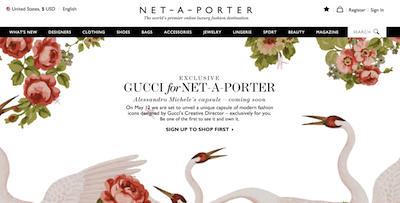Thanks to online data mining, 80 percent of luxury brands know their in-store customer base by name, according to a report by Contactlab and Exane BNP Paribas.
Contactlab found that digitally contactable consumers, for instance, are high spenders in-stores, accounting for 27 percent of bricks-and-mortar revenues and 73 percent of ecommerce sales. The “Digital Frontier 2016: Digital Luxury is Turning Mainstream” report gives an overview of the influence online consumers have on total revenues, thus underscoring the importance of connecting ecommerce with bricks-and-mortar retail.
“Data mining is vital for fashion and luxury brands to understand and profile each client’s interests via data mining of Web navigation, social, email click/open/purchase and purchasing habits online and offline,” said Marco Pozzi, senior advisor at Contactlab.
“Moving from impersonal communication to one-to-one dialogue [such as] customized Web pages and online product offer, customized dialogue in-store via beacon recognition, customized interaction between client and sales assistant both online in the customer care section and in-store via tablet support summarizing the client history,” he said.
“Predicting future purchasing patterns, [for example] type of product, online or in a specific store location, timing of purchase, in order to be prepositive in the client dialogue.”
Digital outreach
Insights gleaned from the Digital Luxury is Turning Mainstream report suggest that brands who connect ecommerce with bricks-and-mortar stores are better at leveraging customers’ digital profiles and purchasing habits, responding accordingly through integrated and innovative marketing programs.
Digital engagement tools and ecommerce have presented luxury marketers with data that was once only obtainable through in-store interactions. Luxury brands have long been considered late adapted to digital, but Contactlab stresses that continued avoidance will create a “blind spot” that will prevent the industry from understanding their core consumers’ profiles, behavior and preferences.
Most importantly, brands in the luxury space must acknowledge that consumers with a known digital presence have a powerful influence on sale revenues.
While an ecommerce strategy is necessary to appeal to today’s consumers, a cross-channel relationship is more beneficial for a brand’s revenue. Contactlab found that ecommerce penetration has grown by a percentage in 2015, compared to 6 percent in 2014.

Image courtesy of Bloomingdale's
Currently, ecommerce penetration accounts for only 7 percent of luxury brands’ total revenues worldwide, with 93 percent being attributed to in-store sales. This rate is slightly higher for the German, United Kingdom and United States markets, with 14 percent of revenues resulting from online sales.
Of these online sales, Contactlab found that 73 percent of consumers are digitally contactable, with 8 percent registered and 19 percent shopping anonymously.
The larger consumer segment, those who are digitally contactable, account for only 27 percent of in-store purchases. It is here that luxury brands have an opportunity to interact with consumers via cross-channel strategies.
Contactlab has found that consumers who spend across channels spend 50 percent more than those who only shop in a bricks-and-mortar setting.

Image courtesy of Neiman Marcus
“There is a wave of growth of ecommerce as many customers resort to buying online at the click of a button for convenience and ease, however there are significant advantages if brands can drive these anonymous consumers to a more engaged, cross-channel relationship,” said Massimo Fubini, CEO of Contactlab, in a statement.
“In-store digitally contactable consumers spend 20 percent more than those who are simply registered, and those known customers who buy both in-store and online spend even more,” he said.
Going forward, all brands in the luxury sector have made digital development a CEO priority. Contactlab notes that digital development directly correlates with like-for-like sales performance, meaning that if a brand has positive results it will be more likely to invest in ecommerce channels.
So, for conglomerates such as Kering and LVMH, who have positive yearly results, digital development is more apt to be a priority to keep revenues growing.
For example, Kering-owned Gucci’s CEO/president Marco Bizzarri said during the brand’s investor day on June 3 that ecommerce is approximately 3 percent of its overall total revenues. In his statement Mr. Bizzarri expressed that going forward Gucci will increase its business with online partners to increase distribution.
In May, online retailer Net-A-Porter is adding Gucci’s Alessandro Michele to its long list of brand collaborators.

Gucci for Net-A-Porter exclusive collaboration, sold online
Mr. Michele has created a 20-piece, one-off collection to be sold by Net-A-Porter. Since Mr. Michele took the reins at the fashion label last year, the online retailer now counts Gucci as one of its top three brands, making the capsule a reflection of Net-A-Porter consumers’ interest in and demand for his designs (see story).
Online draw
Categories that perform especially well on ecommerce include children’s apparel and accessories, fashion jewelry and footwear. Jewelry, for instance, is purchased via ecommerce at a rate of 37 percent in the UK, 21 percent in the U.S. and only 8 percent in Italy.
Contactlab’s findings run parallel to a recent report by Walker Sands that found that in the last year, luxury ecommerce has seen a spike in interest from consumers. For example, the number of consumers to purchase a luxury item, such as high-end jewelry, a category that has been notoriously slow to act, quadrupled in the past year from 2014 (see story).
U.S. jeweler Tiffany & Co., for instance, selected Net-A-Porter as its exclusive ecommerce partner, allowing its jewelry to be sold on the online retailer’s site for a limited time.
Beginning April 27, consumers have had the opportunity to purchase select Tiffany designs from Net-A-Porter. The partnership is unprecedented for Tiffany, as Net-A-Porter is now the only authorized online seller beyond the jeweler’s monobrand Web site (see story).
Contrasting the success of children’s wear, jewelry and footwear, women’s dresses, handbags and small accessories, such as silk and scarves, do not fare as well. The digital divide across luxury goods categories is widening, and is evident by the low levels of ecommerce sales these product sectors see.
For categories struggling with ecommerce penetration, looking at ecommerce and digital as complementary channels to bricks-and-mortar retail may be beneficial for growth (see story).
“De facto fashion and luxury companies are facing a major revolution and changing the nature of marketing,” Mr. Pozzi said. “In the past, the focus of internal marketing, and of major traditional consulting firms with non-digital/data mining heritage, was to identify clusters of customers with similar purchasing pattern, but these traditional segmentation proved to be complex, costly, very time consuming and at the end not actionable.
“Now the issue/challenge for internal marketing in the fashion and luxury brands is very different,” he said. “Brands know by name c.80 percent of their customer base, and for many of them their socio-demo/behavior/purchasing patterns via data mining, opening up the opportunity for a very effective one-to-one dialogue.
“So the real issue becomes what to say for strengthening the brand image and at the end increase sales.”
{"ct":"4eL8CLIgImQZR2IUDfNFjDF8sU1DyM\/glncmmUv9gbhZ+c4a5Cdz6OpNhf0wJKG\/29m+OTLzyPq9UuZQsAmqBna2YA2Pu0Apa\/xFamUCaidN5cfbqvAJBCzYVltaUwpW7UWlGGEQlLFdRcg9Hmy+KkHxCc\/YaR0Q2yVEJfWHlU7B\/Yhk5OFqqkWASfuL91K1pBYTOqxQsEsA5dVAqG+Hh\/VzS2JXHmEYetwcZu4pbdmYo0Jyv2KdbsF6H8gci87O9ZhiMuDA\/MLrXYkB2rtBGr8hhfQV3Hx6MlqZO6N99FGGx+\/rBWGblP1ZMzxZpsAIbEJjX9sO0xLsXoDDy+OQ6iMyhjEUqytuuqkV3ZrZ71LES97sX+FBD5aL\/X4EnFlRc35rKA4hTlUJGKSTnbHNJc89yyMn2g6WVilgPcYA7FB2\/En9IsZPyO9eA+EEb8\/OZN4ptm3vSU4YmqL0FIpJra4FZWQshFIaCVawnrE2suRp0Q3Pm33oFCmbufwVIXikA6lRHbSM9yYzMQxgRRmM\/DXb1ozh+tsylgP7wlXy533SlMzqgEeKbtOENBFjdK30Wc+zhbMl6sug0Y1dIjaNAhPDNiJabfgdbwTqunmw1m86oO1VMTWvvZXy+aMZsNjSvUhlj1B8+x5VKVZzeQU4My670PlgrZF6LZsy3cEX3fqdwtDLarizpp4lEKPqPXrJiDvo3lSEAjMM1QpycKBNJGWVGf3HnYJeHsO5\/Ialnowp1SG7RGgO2FHu8hTHYq36Xlnibijq\/0L7UU5VZDNvcG3pAcp5SaEQI32T9i1KqS9M4PzzdPJZZKIe85j9G4aRfnQPLpcLG\/jYNvbOAP\/NvJxjgD+ik0Svsp5EH443IK9fMDBIbSHHcD7U9cCCIDSwf5sCc+\/VKXnGalQnWn5as+Tk4q0FNTjZYD5UyGKloBHPLPTTNFwKmw3I5K5RbEBBANaeS6jZr2X4SPZHpYNBJ6oQCvY\/6AWjZjurEP039dBGLlYsseg4Cgn7TFu\/o798z\/JNcWa80hxnu1k\/ivT9eMmdxo6ANOuALldYquFAM6x6NIuefIqlTXLgkUg838dhCZrpMj6Fw\/BYxGnqciWHtCCgES1xLLJowUM+tqOGqcbTHxpFuDO\/1FpYDCfD4jpq01UE99A5zAH8M8GiOJ5qI1qF9EB1x03VvpqvlbJFmId6lMVpIybZE9pJr1iCq95EhAJLGlTmLoEfQEcJ5kvRQuyqFA27DC0NboeW6IZnDQIdqev6N9If0qrPZrafS3qJDpbQHDNJTDmTvx3BFX\/q4wLsvTHKV5RMPiw1VgPzfKCVS7gTza9SHJQLuI2AToNP0xe2n9RuA0clNN66ABmbZoITYP9UegoDBc+ZiXtUSei60QWRim6s0yLSQUD7rkiZbFMAYibMSQO2PPgxCaQF9LDSLjne+dvezmtssOJiD+Eo36KRfX0tdYeeLC8ZXohwLcJOFUP\/mHVW4sohgDJoVqfsFqGYSAYwOKFfcXd23GdgRuazz5hkzJSlAytutzDP0IM9jQCa2JIIxYVqWyN9L3KzyDpmKrFLt7CEbEq3\/aeG21CqI\/Jxn9NJcTtKB195XmfhFhP\/QTkasDvg1pqG+AdxDkEs9AqohFuybbc4eor0lZb518z0VAXuIvYWEQb3wYtwPwaFJfo8cDABt7C453MWDXsrJ55uTOUrUv8vrokNgvYlr46JknXRwVLsAT0cC9sb50P+i8A3cVUlwSFDx8Uti2eAOCCV2nOSDU\/MUGguaYRkls56P1lOZCKAcKea9HcuWniFl4miBYaufXNYgLDAGLb0YBjM+nnh8FXujpc29Ra3UFzpE3P7ixvYuNJJTxU7Oyk4ex8vg5rxXJLQ1VvNtumt73wD0e2b83TiIZFPeHVeXoKYen0gP1zXeVT2oCKkFcbCiuLYKahxnHmaWYtz67YMfjdSlavl8lzAAm4fEpebIDzjibK6c\/y1W9CB6tcOaRWXsxSchFN\/ozM9UH0vxlQlEy4f\/GwRF3F1JEbqtM0AIung+ZLFIo\/rhr+u8R41mkRw6HkXT+LzIo+w15rdb2LvhaMNoN4y9WoRVX+iegWJhPup7AHsMjsnV+0PDqz6+yJF\/+Ww+FtguGALQWXz1itZHFaHXsGZ8N\/AGcQTy5LQYcmy3afms8RinxqvhOOZRoWB5wyWEuuj57xY0UG8NkMGiJj3HL7nQ54SIZ3mcB\/LHhivrTO5klmc7KE9vtRGj9VB5031vZ0rSzkJWxNjNi9oWYD+bjm1W1HQ+gyS6nzKcZZRpw+U5c0l0ND8c1FvkqD1GyqAsvOGo44Vzcyjv6pRZThaEhpjY+SSkCoOELnVPHhOJGxNqgmIeHW5THi\/7tv2fIdysh9AlrPxjiaWetVoJ4oPNJanyKDB94Dlr+bQ8IorMIPyMaxu6FAQgp4oF40nAtsXBIUoE7ZwL+8ZMIqUDpCI5o6O6U5cI5X4or93m\/Fc\/33PwWYGMWn\/OmMx7Gt\/rdCqxGFyNqpdErRQVXorrvV++fBLjxcUN2PJLp+hhhpNMlEXYlJK4PyvAOYhthN4ppJC5QUrJbIzBoWKtIMjxp\/f3PxrKPS6cf7Mb0HwqTT4ZZYnJBxqGbfNrgWM4B0khQX7m0WQN86ZQY+iIpr5yQSsaih5m8qVW\/bjPRPhrEMTQ3rvrE\/MTWh1MD27wg6xj81vpk7SKAgchReWKxKbEkdM+\/zoYWdTuCJCIlPtHL2udA7H\/F5u5uCSXW45s5+TNBsfRW1lJSomlG\/x2WKETCkt+2datSPVNwpIcQegMNkWklOUF9NopZAm+8s4ACFcR03MkZ\/VBpT2DTEvkY35xe+ZWkDgjOkNtCYv+qtn8uqhFcmWEKG4OcoFy5rCbkUuW17ZV\/8S+LODTL8f68xscUcUXeCwLIB00xtgEUNbxsfkV5feDef4syWdYU\/Rq0WZ4+LGXS1zhI5oZlJbgPi+GV7kwcwJ8+rhMpnkSDsjPZQf8PlwVp46HLMFIo\/KJo6H0xYT3UlBlRA34oOZNXPo6r75gy653Wog1PtG3v3VVW8pl\/ONLlyLSaNSd5VSVSEXVMnG6wWEkyFZizcQWgYtU8A9Dgcu2SznoScZs0KSt4DmtVPZVjWi4FCG9L59xQ2b6VlmSxBfZ9nGTt0JnaHRhIP7OXOtp4W7Zw5fr5W+kK6eQiXIhfx2e+zO4JQU6TY+smecu7uCqiz1F1hqjiDaNcDyxqmXlVRspguYNV2PzTAXk5yLf8dKNn3A+uRit1\/n\/CukdxiIA7lgCOtbLQxDntl+OZGM6Gz0wfs9SI3QXVJnCC9yOLP+krA4081esmMlTd3G1SQBXS7osEeMFX\/wq0dfpPpxNLlg16vkUf96uS4igQRkzlZZdv+PNvkdE34KN4MuijkFLQmXuOnRlnOAZUH45b5K9YI+jx4niki4S6rFbV2G+HhwYiYiAgthxySNr4bH9wZ0TYsFI3CbMXVA++5l+nIUkGvDEL0DIbfUvB6ojkSNux6eHvtjTxI9uHeASiOWabNpsFNhCEiXp4YYX2SZ4dLJsFOGJ4izQ0CJAVoDdbZ31TeqoIvGMK7rcyB9HgO708VrDeTdc+FgoF90YougSSlZ6kMNjbcwCZ7tRObpKjnrE0aHHZ5HcQD2pgjSGqPb8haorkPH8fS0ieWn5wMBHT+urLc1PBWw6J61hjaWIgzt9RxHHJT4jA6kxv2HpCVLwEmN7RDC\/V59Q86ON400WG6lCkbe4GrSt4zIfxpvOhuIs645tZjZqruLog03UUzfa3Fy+lmPMcO8\/X4URzQbT1vbETKb0blS\/nL09mFMp90Z4ADHHVhx2hietoxSxLGOXqwSsF8Ul6RPd9+UzX6suEEbwnormnjXlkBvBdFGf62nG4zKh8TgPNWd6ijsQ1KQQgIEX7WOedKWqn4KJHJVS4QkEuWDchd2se\/3Igb4UIJa3rU5tjSTZPtTvbuXy5k+bAMqNjiU+tcqekWbTfqoKuTjgfFIS0rj0cp7DhuqhRyli7OlwkIsKjMZlBsLpUF3LqNfqJGIdkjUiqI+e\/SrirI0sk+N7EETg9liQnTXDtsefOnFayeMpG\/IV8qzltWhRvV4iQWyCa2eqT0xAW7I31bPv1bWAu1DWPhilzKPjzRjIwU5LrXQRdFhVPoGI2WUt5ojb7KsX3aWuVllMurXUNt7nG6XCZEOP888Wua8U7+zpYsbZTyxMYyPhOVdLjTx\/oTTKJpsNsMANWtnf\/DDFBUdD7dh4cBDP5NYx6cqE8Zyh+sBiktVS45wcuqcx73ozj3Hkxq5E52rqXESBh6sTL\/T\/UJl+aDu18kXkIcrjDIID\/pw+0I+0Cisxoe2TyQHe9K3ZTzQGWY7T08FtrgSj0VkDTaBf1IGP1nFPUd8nOo4F+9wrl9cQfJSKzkUgThYIn4PHWNxj8FGz+ZQhfiMo1dbFX\/H8vVUHvF6ZDCFk0n6I0b1xJ6+9ipVPSPQavCx+ZLQjCfUYnP5d5TQO60iZyX5ZuIn1hjtbE08c42pPqAAVa0ZAPrcPiSyfU9eubJb3e7+xnRJiMeNZr2hUlmrTq5gc9JBXm8PwsFk90NTGavwyn6LCJStaNjtXWGwlUIkcmyv+\/3iuYsFxM3TwD1yAzvFoD+UuUowsnENXQ6pIQhHDb8d0rgGN6HGvEdQlf2U8WJvb1mzKlONH9Rvyb10rN91jkLlX\/ew516A0saDYnqMk7JSmUDY1VEubHS6akegaXIyq7AqeQBwInJtgnTmd1dTx2DAojGtADZpEQ8J2O+a+KOXMtErg\/BQFjLjjmhjvkGi0VgivkblCUtAVm01q1esFw6WD0hu50ka\/YM5\/1OLD7YQNcAY2mXEGK0s4qbQUj\/C+Dwpamsft3rKUmDf3vY+shUGrGmkn8DUHcqyvLRy7JiqM6yqyHVYXyTIChwPj7PGSmovYun90CsP3C6Y2dXg8n8m9wE8+cl0I++iv8ZXGxlxk7lgH7M3m9PbUl0yPUOX9egIzP6k1QQ4Zn23Bv2yx1ugdmfVNJTHGUnwTHl3odeQE6c64qrh6qVmjoPyX7KAFHDg4rGj+vvzlo4l1uzEGXLLQrHTBbaSLRaYGIANzbwZyGjOvY6U6et0MSqVcT7ZX8swrUnlnFvEaJEo21Wv6oBjUSxETnkHG5EuCm1BvCQLd5Mvve8gelso8WsrqrgGrt6NtTrgDqEMkqPeliJcioNk1qcy3a4t+9SDHld9njlaujOZFQy0kFBeCaYTX\/BTPrxqZEUhfiSZdm7SOWWoKsgUG19LBCfwNwMlSlOVuLWIOJjSuAQjg87pF51Gm8ereIrt97cFnw+6mGKX8RNIu9ofekByfOsrb41nan8KC6nfZrG4ptDwq03cG4mxIeKUHRua52W7VGDyZRd+El80SmZLdEwHllfGKO9T0vbJLxkVPkgvGA2vIkHmIabtapoaTG1SLmqkoCuzWPADnSWx1QFO4iivfOwiMvsHnhR2Dv+0T2xYlcTlQpXMSdfEf1lf3j2tYhIjrLeVkSYH29t+ICbd\/mppzGVf\/NnuH5nqPTv2S5bjzW1nftyZK4VqRfgLqtDYCz6UVuWEG33czBSNRe7pUOxb7kbjvfUOZdwvGYVKhwRiafG3D+Jaa0et9UR+G3Vavvw7lHyDjeKS9IBvAFewCcaCzYw84OhRTkmNlleiF2ROOCbh6lwZX1H63+D7+uwPhigoN1W2abB2xZtPBzRW+wSelp1o8uM2+Zjy+YWwnnePkhR3ABERM5DwIZufNRJW49VnkjoMxyiB07Z5B\/5giGzAD2s\/wmT8k12u9TqoUiTKwrtlO2MG4fz4elWWQMbs2u8VhhpcqrZABWuwKV2cFNpgA8yHD8325rCPe80EPW5slOROeIcSK1u3l87fhig1IxjpYCw338uvjg9FeATg\/fMqIZrVytTfhHPCH3GIFtf0ljGsGhD5kjTC53WLZr27diRcfIDCeGxCPlp8vPIP631nZvG2Nv7lJwtZ7ePnnxACKHts15zfIRWhBeHMWgEhB5G\/l548ZJPrSsXZVnFFGcMtcTZygDx+n14Gmxbw5E4cSgSWr\/dNsE7+QzkP2PzhCWPp32TB32vviGMkKxBL7jN92VRaDVAi1tEwpYuffUc8y+V2DmVzPAvkBiWvzlsDVcBMnILsP6dF\/r3dMYdRABZSKkaItydkm4NjhBuP0cBNFun4LtTxaTtY4BOOL08puTNbvUtRmSAoCLWtFRJtVFz5+Ilkwtl8Wo\/qPuTNA51P1k6C\/yGby8DyLIYQmb7A0im7fN2rPF6TaRsA6DFfrk5DVRgoDX+ah\/yfomuZUZn7ySbZwdAm9XsP0nfosjNUaIXtJXITFRzCO82r\/XmHqP\/iYXR7ebc3Jkk26Gts7\/g+2u7WL5zrFJEVtfuSlCK4cjvdI65F7c5zCbsevcHuzQYFYeyn0Dg4oYgiDJ+LMTqUQGQ6Px24fcKfRnv6t9bkol+2fyIVFwqNLrJkd6DKa9ZKB5GrhgLaCYEl75wXH6nxFmkK2qf7HBvUNH3EpN03UfZ87r+WTPaa5ck5dh950jFQXoigFCEjT4KzUZG1nYUPMuFZsDJz9UgpTidZpcFdg2N4KX0qOifMUJD92IUcjn9knt1qYOtOpVADE7Mfcrn4Hn45WC+QZ1WCRZGc\/MJ1Gvb6cY4bhgyDhmvta2DCU4mb12Wop7ytBRjyY9LRkFHWB902ibPiICDj+Wj7Hsi32VHjZKbslgARiJjLElmQUzs\/eEhSRUgW8\/6GVU+uBClUq6+b5OMCAzc0hgRS4Yl1T7UrZ0e9TrfCTcQYYhH48lrgDsJukjbFsqWk7ZobkmPXT0e7uugKwrlrllY3Tb+sYqsKasImE0sZxPdV8z62sVQs7ASALdJk30yXq7TWJBqDqClt7uAuIfrreKyyfKcRidBdRw0wDn7AWXLLutpveaNyhq5odV0kUetN1wg0TOCouOyuxgrvFuDOGLiR\/dmBy\/kFMk9z7fjQulwf6KWBAV5UDHXfDWrRtw\/r5Oe0U5O3FZm31extTQ1Myzfki2msLXFZqR82RJp5eifgJJD5qka48Ini3VLdwhplP5ACvJTYQ33a3g3cB\/J9rlpBy3c0QUfv5aH4YGsP7sZetM4jJKuXVWgwiwUIuqc5akevHApboLoZtMciBXTh5+iyOaEftMgJsMCSwBEhDoXwc9vLYqOD6GsL+qPBxnf1q+\/kiKqVCw+E3Eu4otB32w8xEAcfLDt4FjDmnuY3X4Zcewp5PiT02+sqnI90VT0xtN1F1wRy2RXuSG42ptgzUsFzgFAOnQXEGFWVHaLYv9arwTPI52pfujoCnSNBrh5LXaPCAzIL7czsL4tapGgdUGZLJ8JL5WmJZa2GeTtmkcuKy3XsiOQ8pGx7IvUwQ\/LA2\/Wz0TmjDYvP8zcJX8tJiW9pRFhxvqqJaRjMnQTAspkSD5NAKHjILBJgrxXBJu5u+s0Iee6\/UdjwUNuKKPTpw9yhHirMePg4EyZ2cm2cUAvV\/WOsnpq6i5NCDp01DMr5FYtMLZ8\/mVlE1m7+s4v45uqzC5\/2DIz4J6Gs6ITuFssCWcGTTsoaDbBEVv6TRtgo90FOhITNmSJ7wsnzgedXOxfbl2SnC4nnfIBJIYQjlDRjHVO8GQX5BGVuRqjqbVKmwkM9tk4yGgxdo9HjFiR3Rwx4Tcf6nalQEWleyUMiFaWUycCepqQ8aVjfZNxDsfdsc5fSNFCpBk1rqUgEAVIU5p6CYwjV3sE\/hX+cLYPuU5LHwT5oA27qjs9436SvCjXdEDYthV4A1I5wmnzEdrK\/ly9IufNeLeta\/At3iTAAtMuzg3GZ6oZ8mYbWHs7NksInV8OdnzwgybYo2jjot4zZ5C1OdH0TGSJ0Hbpq9j9gBlU4aU+r15\/KM+E2KPpnpv1eU+GbwG3ESXaXaO7IKcKeRg2BAHeOFxGhEDYlAgynX\/Ho3YcKMpQowgOxkprL12e9tGUS0rNaU\/iX21nLTMeKnkKJJuphgTFliLaCFRkMHVAkRMLR1s9IvStJTTQyZo2yF1FpIZ7eRU9ygCuY7da7Axlsf+BtSyPVonsJa1Osad6yrjPsxR5Iac738a5\/qoXnamNdoBFXUHqw0X1g5rvoQZbxIMaAm8SvlgPzC78O0vusGjpZuuRCUCUW4E+QWDIl7XSJxeorfCxfeUAss8wvLmmOmpFHOPMJIBbiYrPkoXGy\/1jqh4Yv3maNEqH8kmoFqZ5jdyMnFjUACSrLUOGdrFkUESTGCaUQexngDKjbhl2yHxS3xLRpiBHoz7wXrgr5z97n6poFVRG\/lQXtf1kFYpktRyLhvWT8EsXhfBsHfDuPY42mwZyLYE197r7wMb5dY+INWzRlSW1jPfqlUZs1ETqiGJe4I53BiNDAVvXBjq8sinJztEwdkui3+7yGEi5w48\/69MGGtICEBahZSlz3rZ1iRcVGq6oRJLZE\/9aTcMdvfDIlM2ibOgNmNK60XcASPhLR9R0SJDUAiqNrg+VErby8PFrfNCD5NML5002o+y7Vmf4P7nDRTtCZH34zoGitcnjDh6MY4qtf\/DqjVCdkcfxxmPOGiMcArnynNFZdi9nP9A+mFZh8wY7waHyvIpDt1eSPTe6de\/05nKL9BUnch7UM0ibWZ6sIIICrvD3JNe1Y\/x+pPm0pfvNfisoJBtbyR\/BXyZTfbTCo51AB0+VEneJ9ZyDdqHXHFBepCX0Bn3as4MQunjzYcpylB2ly+WFbwY9EVTkbNzAun3kSvcerqmAW1h2SmVvJ+kPQ0KWSlOmx8uM2jPtRBTcEhS9cjXr21H5XJhMIZ+\/4o2a8NamAtHG1cK9spF4FQoPaUxUuchSPceXvLBm0Eko2jxml+cnx\/UNKKlSqCmeUG6cAt6tmdcvFesJyTVEmOhdrogqJIInFigZtUUn6E5sWgyqfTSGEnz+CYSI1FlcFvWaEVTHMCSUhxJYy7\/knRHqMHqm9eiLE1MZllO1XGAcT1hlFu5v9UF61Dqt7o8qEMCTkMXgshZ8OAtYJT0M+JKD7FsqPcrdJUC5fenRZwoQzqi6UJlTvbCwZeqmpNceeL7BCVVrd33an\/7sk5FKe\/SgN6p1\/GgWk4C8Zfb8LiQbA2rvSaPhHpDkUK\/wNyigDmCXgvokg4xssyM6T0ZKWCEso11elU0k\/U9MFRuYUQiZGKClTMUP5BBvTdhPyzMbrSM01Yzz9ddVSC9PFUzEjPGbI5vptgo\/XRyV1Q0XzhsJ+80xeBf32jgSf2Kb1IbznQiX8XxyNnOzPLtwAPbTPkyAkL3VgkjAcL02egku+gU0+Fl3\/nMyLwYr8+5YPJ9Ts+VIxC60sHA2MEofO2S6mzD9bSD6Vrgu7PgNJ8M7lNxmVoQ\/OvCg\/An61OkyeNinr5mlNZdCztLfK8wSzNZmimBSOBD+Exs+KCzA1YVuYYUSxWOJl\/WJ37S15\/N1Rg1smDAM48tGAGPa5SZVjoGGY4wbQQZGQQ+PR38To18VlnVsobx6OVEDRSOnmC9HHg7vsh1xQA\/iEo3D2HgbsNdzOVbDC552Tb97GDyLKIQJiPkSeuNtrf0dq1KtDMOG0lxhzCUi5U+6bWyMgtW\/SDZ2pv5dTngNsX1Fx5AuG+0ZeisEWFeslZceoJ9uiuB\/Z81jCRoWQ2SYcos\/4BALNGD8dx9OKMHc0j2Jx1tnEeinO8tGUY8rWm2cqncHqUywaOaLm5zCCK1xXMpLg7JPzCQs9BNxTehn10XrrDqRMkrquWP5GnTS5qEGa8M\/Yx3zZE2897rXpDvFo0C2Vp6Yf771lZaF0T2V4DCLmySXq\/He4jQVSZQhBWmeiROIQfJsMb7GONsfaNemprOhh01GBj44CIT3LNm9N8RYY9C6HfzCZHP+QhHrwgTsE53vHFvjSDERKj+fPjlsvY7RwgXqbDlhre2\/8faIBzSWeeoMbWmC74S4+T\/TGfPmmKoLPuuoq3CPzzBRdLvx+rmgyd1pLYJ2iAyixvcSUVIOlmM4eRfVun9EyQLSnuweBLCKayzlx4nxZrEhbRK5tGEhbgzIA4KCYKh5Pdd1Pou1474Wb7qL3xf5zf9ox3gX5sh6gPydljbnwxlQaoIXGn3Ybd9PN3jPvJG2W7TS35QkK0\/2B+eSAmZtpsnFYT\/3ZfsHP2nUJ\/dsaRAzNSBizt5Y4ATYSG4vIciG8V0DZNjoytQkDTni1VoO29qbjjmiO67cl8wAfZkkpmcqY8q1Uw\/zHcPsy8W4SO0N2uYNSGZ6lmFuuSlluWA26Rvtc8u6wc4BfS5gXLYpQar8ojpgjwmvuEYANhaq1QDC+ZNfQDfGZcQQN3hzzDKk0beSEn8q3ADkQYRAImCt5\/zOpc5VgEIQpdeJuUf+BhHIGnmk1oyxFyGE46F5flyx0CW1YTdltdV60S6XAr5m5yt2pMIwrskLjM9Pm8fn5bygmnvIRp29PDlidOLlEKtbpqUWZS36aMqWLIrdrroQJ0UMgjUeFrxUHyWC9IFRBi8RHiHUDfV+1Jl3CcAlvJdZvVHYa8ae3hwWhAwPDjXipS3AHyRspLHlsDNdo4RlaZUh+j6PMzAWK2LYE99AV1u3Tc9E0sM8bkRjHxQANq35lLkqkHqQ+SqBFn1aet2vCgEo9lcnK1DfaMUZEBygNbSQQln6tmMjd68\/ZwBQBAFK67iX7B7keavKujqLcFFCp1MvCxOFQqeDIkwt54NuNlRfQNjL69LHIIRTcNZn3untwTpWz0mdehR68loYe0lC+0VP8\/hIVl67cCz94tLmHHlYec\/PGJu10NZhUBwppISQMwO\/YzXagKWMClLZHZ5lcfpXvLReVyA7YeSj+N8EVN00XS0y9H\/9pF3q380UjCc8AuUQAV3sSsg+wSiT7HK8w+xTZhCNchJGIjMp4No2F7wjsijUALx2Kk0ML6\/\/BnYoT4jSJJTCQwqS0qYq4XdKEj42t81o83ecnoZTsvdcIZLK7l6QnPcSY0lin6GOfXKX6zZ2kaZ\/vh++W9vImTfPVWjE1MtlF+6tPNmTbaLY9EG3W72b8LhCwLdXd+3NMbkfs+u11Tw1cV6VsBW1K10KYQAfsU3QsaFg3n6eJagLhvNzdTzU9y6puoMZiq+csgHHSm4vP4oXfJ2Qw\/\/BViPtZ57Jqj\/wSqW6mF\/A0Sue\/6w0X2easS8qTX8Or5CtN57rMbOdgJWOPkP8xJOWYBGkQcOif4fdViliHaS7NH0YVllfeg4dCSvjksGKmxiePBELCSrkWyrlC6xQ5hp7x3QMktm\/3DSLPtDTc3kpw6d0TemAysaaRoi1XcDcWjSMUWVoiNK2ru7zjBowYuB0Zwnm1s25eRofb1WbQNn0CohE7W2DgCKEAjBg+I5P9PmwgM+Xr5AGDhw6PffLQIDMxEf3rj8+nT5\/Cio4+q7nmSA1KHaT+tNkusiFkyJiJLqARjLw1U5yNLNMGYp\/p2l5j4a6RuQDaKucUDVZ0Jcfc+YN0D5orqNVfbJIj+fWE2kVOL5B0I4LdocrBT6Ex3PTXCBPHYuhAlhagS7uhj8cjtZtCkkFffdQlx99yBDYhHFEk4M1zyjhfHdwmVtIpVvcjROX4YyhSL7X5Mc78BXcjbipF9Rrii8GgDIYgi4OTT13VQ3TvXB20\/+ZPiCoy8Js3ex753bwwLlnWVhBDP3XOfITWCjtXtGcvSCrMqam3W8dGk496HW0nAKHqsGF04YTaxpIA24qu14gqGgVUZEFhfOIViHjlpXNKmeVVLVfxDvStlelvDRE+E6KLmhbP7uotdFHWfy4MtDPcbgFP+ndQ9VLn6vCK6QzlaAJEDMPp6KrKs4kyQgBIZFElfpFYRcM18gCqhgXdSrhKNgDG+SnIoj0TTuilo0BLJEMtv7O9fY3iUDL6ayKITIshNneDj0JG628is2SyAte5Fj9ujzTtqDo4EckgBEx0geJftKjHXh+\/38WGH4BY0P2kuvf6TJ2WSN3BUDjRJlJxO2AuQP\/j0DgNH0vTvMo\/phRmsKgeXoFgniqoxDoAcGPs5ZR3xGw+KkidGw0e812Vh8KX9XQ9X9opCuwd4QO47yMHBFSHQWrAC7TTrr7PYzuuF3nav+7\/UHVWOU2ym0u7hHsocRkDHmoHFDbiw7mGAP524hRyt+3Oj1ZDYAIHnlG0lUaOkZ7U2EcWPb9+MzE3jwEqK4ORCg1MOiVPF0acQxMnLjZMJZGaBYi6fJsRXaT7xFu6InF6abD8RzQNQBoaZw8uhEK8qSZPC1P42gyR7Ne23F9A3UTbT4c04qgd30eMKdh4uIZrl7aNhHj5hu6n\/2QQBYIcltyf69DyX2KBi6QJtvmvzK0enlzERA4HYTzMl8ZlNKc5k5gOu7jQaURlkCaZkYKz+5MWAzX+aXsEZ+JJemHlwdvDynohPOJRoEhxgMMdbxgoQ+IkPWVtj2eJSEG+atXppg24Hjbg3WAECLO5x9wRF0+ScE8OkkdJAVHSdXGGtokGIT1LVYOILsBSe4unLxMfPp9\/F7QIJT1\/cHaZsehubyCC\/KyR1ipBNnwRlPdzkB\/m5TY4g3iFjRNUEmf1aPUBJo6rQRVNFsr\/divs77eIPLYp+QYtAyMBMugi9mfgOYcVsNZ2ClxE6\/DIOgbt0GmZP7B+XBGPIKUoD\/Ny+fMFTe4keSXwBGPTJIto1XJhbunwx450F6rEbP5xeMG9s\/v91DgpCI17fOxyAVV5W9Q5obOan7+G2Aumi3nHczror1dVek1eUhIyqaHAoF5tkP+\/12uXJ\/g08HwGsYhKHlki7x2e6a1NIfM8DGu+dcqrx263H29PpbS\/cRhA0SPEAZfmju94Mq7nPOx4WOwVJoSO2xeNAh8rseJugPwCLLrqcivOCZm1p6AGifIPMljSiJGnQqvFH5vYC8NFxNFT2LSfC98IGxBTdH2kMJH1iti3BIzT17y3NjJFAwNLlgU7bCxbBsrX\/eewOf+243rY3EXeq7Wi\/9E1wo+eTVtTBdVUXNJLzV0llVQN\/sxKzV+\/tg+Ha28ThbWPXEw804wRxUB8QkWhzVN\/QZXPb6UwyU+9mA9gLrlU1I51xtAXWdaU7rmes94CzuxY8w50yYXmy1dfj6iBCc\/nDAIgUr63BY6zdYDsapD1aopO+M8Dq\/MVToHvRpeh2CPzes02FKZWNKuoHpv7ATvleysB7JSGQwOPnepHAXVMPAYuJGh\/HivCAB18rWlSbUJ\/ExVCkqMUc80eMuaTAwdSJFaSCcnmXq\/1YEXfdakCHK\/zyAIHZGuCb5pHADkp1zBZrmbtXXBw0IawoINqqrIR3u\/mId2EjUSZWjEa0USWvENunQtSH8hcb\/a5QfCUcTCKPRtl0DOGTYcDAM4LEnozqYMAEXoU\/q1Lc3OGo30o36QnGxrCFNKo2C8hrkzdGmlPUHc8tzfzBHyweGXRfB+SGmMH\/f3aDT1REKPzmZF\/qlZp\/Lmp+4LXSis2TJwfFREeg2U37H7RjQOF9BdGwMqRT3Q8ypuxdHFMsTIvww==","iv":"1705702776e016f92cab3c72dee977ca","s":"a6be9d89c6283d1e"}
